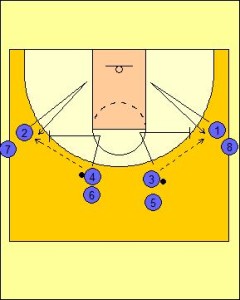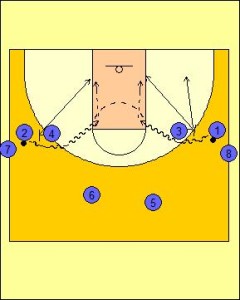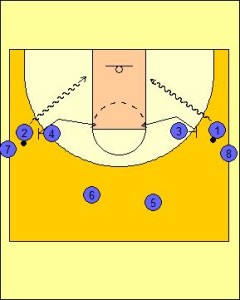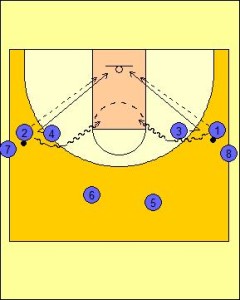Pick and Roll Drill Series
One of the most popular tactics used in modern basketball is the on-ball screen and the Pick and Roll Drill Series looks to provide an opportunity to explore some of the options out of this two-player situation. A good on-ball screen between two athletic players can be one of the hardest tactics to deny at least some sort of scoring option to. It is also impossible if performed well for both the screener and dribbler to be fully contained with no soring option.
The Pick and Roll Drill Series looks to provide a number of different options for players to explore and become familiar with. For junior players the Pick and Roll Drill Series is a great vehicle for first introducing all the options applicable to the on-ball screen situation. For senior players the drill becomes more about the instinctive reads on the run that must be mastered in order for players to take advantage of all the scoring options at the senior level of competition.

The Pick and Roll Drill Series starts with players being divided into two groups. Because players need to become familiar with working in a restricted amount of space they will only be allowed to utilise half of the court.
On both sides of the court there will be two lines. One that is elbow extended and responsible for passing the ball initially and screening (Three and Four).
The other line is foul line extended on the wing and will take on the role of the dribbler (One and Two).
The Pick and Roll Drill Series starts with the passer slapping the ball and the wing player executing a deep v-cut to the basket in order to become free of their defender.
The pass is performed as the wing player is about to break the three-point line. It is important that the wing player can receive the pass in a position where they could, if they have long-range, still shoot the ball for a three-point shot. Anything longer then this range and defence will simply move under the screen to contain the defender and take away some of the possible options. By catching in a shooting position the defender will have to guard the ball handler and in doing so will be perfectly placed for the screen to take full effect.
The passer then cuts towards the basket and once in line with the wing player sharply changes direction to set the on-ball screen.

The first series of options to be executed is the wing player dribbling over the on-ball screen and pulling up just below the elbow for a jump shot.
The second variation on this movement sees the wing player again reach the elbow area, but instead of shooting, the assist pass is made to the screener rolling to the basket.
The third option is for the screener to fade or flare to the baseline for a mid-range or long range jump shot. Depending on the screeners shooting range will determine where best they should be rolling to.
In all of these scenarios, the screener must roll and in general be active in finding space on the court to receive a pass. One common mistake made by the screener is when they are moving and finally come to a stop they are standing in line with a defender between the dribbler. The screener as they are rolling should adjust their position to have a clear passing land between themselves and ball handler.
The dribbler must in all situations take two dribble unless able to make a pass to the screener. Two dribbles helps create space or separation and makes a pass easier at pace for both the passer and receiver.

The next variation in the Pick and Roll Drill Series is for the baseline drive by the ball handler. In this situation, the ball handler makes a read that the baseline side of the on-ball screen is open so they initially drive to the basket for the lay-up or close range jump shot.
It is probably worth noting that in this situation the most common shot is a pull-up jump shot from just outside the keyway.
The second variation is for the dribbler to finish at the edge of the keyway, but instead of shooting the player looks to pass back to the screener who has rolled to the strong side high post.
To roll correctly the screener must reverse pivot on the high side foot (foot closest to halfway). This will allow the player to maintain vision of the ball handler for the entire movement to the basket.
From this high post position the screener will have a number of options:
- Jump shot
- Shot fake and drive (one dribble, two steps) to opposite side of the basket (weak side lay-up)
- Shot fake, one dribble, jump stop and step through back for strong side lay-up

The final variation in the Pick and Roll Drill Series is for the screener to slip the screen and roll straight to the basket. In the initial breakdown, this screener will receive the pass on the roll to the basket for the lay-up or power lay-up.
The next variation is for the dribbler to again attack the elbow for the pull-up jump shot.
The Pick and Roll Drill Series provides a range of different scoring options out of the on-ball screen scenario. Vision and pace is important to help make the right read at a realistic speed. Otherwise, players will struggle in game situations if they do not train with the right intensity.







